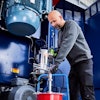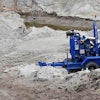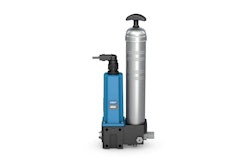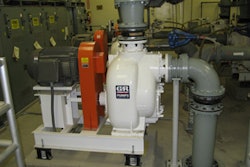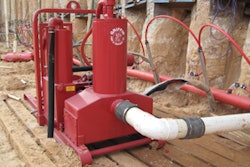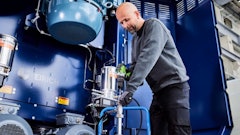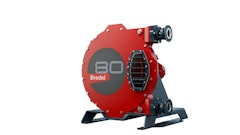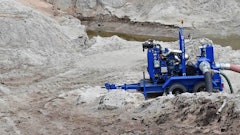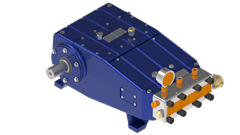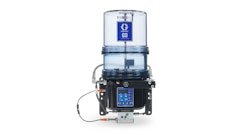Editor's Note: Adapted from "Improving Pumping System Performance: A Sourcebook for Industry" developed jointly by the U.S Department of Energy Efficiency and Renewable Energy and the Hydraulic Institute (HI).
Pumps transfer liquids from one point to another by converting mechanical energy from a rotating impeller into pressure energy (head). The pressure applied to the liquid forces the
fluid to flow at the required rate and to overcome friction (or head) losses in piping, valves, fittings, and process equipment.
Pump system designers must consider fluid properties, determine end use requirements, and understand environmental conditions to achieve the optimal results. This includes a thorough understanding of constant or variable flow rate requirements, single or networked loads, and the properties of open loops (nonreturn or liquid delivery) or closed loops (return systems).
Fluid Properties
The properties of the fluids being pumped can significantly affect the choice of pumps at most plants and commercial institutions. Subsequently, maintenance and engineering professionals should strongly consider the following fluid characteristics when choosing the best pump system for their needs:
Acidity/alkalinity (pH) and chemical composition. Corrosive and acidic fluids can degrade pumps. So, pump materials should be actively researched before their selection.
Operating temperature. Pump materials and expansion, mechanical seal components, and packing materials should be carefully considered with pumped fluids that are hotter than 200°F.
Solids concentrations/particle sizes. When pumping abrasive liquids such as industrial slurries, selecting a pump that will not clog or fail prematurely depends on particle size, hardness and the volumetric percentage of solids.
Specific gravity. The fluid specific gravity is the ratio of the fluid density to that of water under specified conditions. Specific gravity affects the energy required to lift and move the fluid, and must be considered when determining pump power requirements.
Vapor pressure. A fluid's vapor pressure is the force per unit area that a fluid exerts in an effort to change phase from a liquid to a vapor, and depends on the fluid's chemical and physical properties. Proper consideration of the fluid's vapor pressure will help to minimize the risk of cavitation.
Viscosity. The viscosity of a fluid is a measure of its resistance to motion. Since kinematic viscosity normally varies directly with temperature, the pumping system designer must know the viscosity of the fluid at the lowest anticipated pumping temperature. High viscosity fluids result in reduced centrifugal pump performance and increased power requirements. It is particularly important to consider pump suction-side line losses when pumping viscous fluids.
End Use Requirements - System Flow Rate and Head
The design pump capacity, or desired pump discharge in gallons per minute (gpm) is needed to accurately size the piping system, determine friction head losses, construct a system curve, and select a pump and drive motor. Process requirements may be met by providing a constant flow rate (with on/off control and storage used to satisfy variable flow rate requirements), or by using a throttling valve or variable speed drive to supply continuously variable flow rates.
The total system head is also designed with three components: static head, elevation (potential energy), and velocity (or dynamic) head. Static head is the pressure of the fluid in the system, and is the quantity measured by conventional pressure gauges. The height of the fluid level can have a substantial impact on system head, while the dynamic head represents the pressure required by the system to overcome head losses caused by flow rate resistance in pipes, valves, fittings, and mechanical equipment. Dynamic head losses are approximately proportional to the square of the fluid flow velocity, or flow rate. If the flow rate doubles, dynamic losses increase fourfold.
For many pumping systems, total system head requirements vary. For example, in wet well or reservoir applications, suction and static lift requirements may vary as the water surface elevations fluctuate. For return systems such as HVAC circulating water pumps, the values for the static and elevation heads equal zero. You also need to be aware of a pump's net positive suction head requirements. Centrifugal pumps require a certain amount of fluid pressure at the inlet to avoid cavitation. A rule of thumb is to ensure that the suction head available exceeds that required by the pump by at least 25% over the range of expected flow rates.
Environmental Considerations
Important environmental considerations include ambient temperature and humidity, elevation above sea level, and whether the pump is to be installed indoors or outdoors.
Software Tools
Most pump manufacturers have developed software or Web-based tools to assist in the pump selection process. Pump purchasers enter their fluid properties and system requirements to obtain a listing of suitable pumps. Software tools that allow you to evaluate and compare operating costs are available from private vendors.
Long-Term Optimization
Since most pump systems last more than 15 years, excessive costs related to inefficiencies can accumulate throughout their lifecycles if left unchecked and not addressed accordingly. Therefore, optimum design and operation efficiencies are in the best interest of facilities, which rely heavily on pumping systems for the operation of most industrial processes.
In the United States alone, more than 2.4 million pumps used in industrial manufacturing consume approximately 142 billion kWh annually. At a cost of 5 cents per kWh for electricity, this translates into more than $7.1 billion per year in operation costs.
As result, larger pumping systems should be surveyed regularly to determine pump efficiencies, energy consumption, costs and potential savings. For many pump systems, even a 10% reduction in operating costs can produce thousands of dollars in savings annually.
For more information on pump system optimization practices, please visit Hydraulic Institute at www.Pumps.org, Pump Systems Matter at www.PumpSystemsMatter.org and the U.S. Department of Energy's Industrial Technology Program at http://www1.eere.energy.gov/industry.
Additional References
ANSI/HI Pump Standards, Hydraulic Institute, 1997-2005. Pump Life Cycle Costs: A Guide to LCC Analysis of Pumping Systems, Hydraulic Institute & Europump, 2001.
Extend Your Motor s Operating Life, HI/PSM/DOE Tip Sheet, 2006.
Test for Pumping System Efficiency, HI/PSM/DOE Tip Sheet, 2006.
Hydraulic Institute
The Hydraulic Institute (HI) is the largest association of pump producers and suppliers to the pump industry in North America and is a global authority on pumps and pumping systems. Its mission is to serve as a forum for the exchange of industry information, while providing value-added services to member companies and pump users worldwide. This includes the development and delivery of comprehensive industry standards, as well as the expansion of knowledge that effectively advances the application, testing, installation, operation and maintenance of pumps and pumping systems
Pump Systems Matter
Developed by the Hydraulic Institute, Pump Systems Matter (PSM) is an educational initiative created to assist North American pump users gain a more competitive business advantage through strategic, broad-based energy management and pump system performance optimization. PSM's mission is to provide the marketplace with tools and collaborative opportunities to integrate pump system performance optimization and efficient energy management practices into normal business operations.
U.S. Department of Energy
The U.S. Department of Energy's Industrial Technologies Program (ITP), through partnerships with industry, government, and non-governmental organizations, develops and delivers advanced energy efficiency, renewable energy, and pollution prevention technologies for industrial applications. Best Practices is a part of ITP and offers a variety of resources addressing ways to reduce energy and maintenance costs in industrial process systems. This includes training workshops, software tools, a series of sourcebooks, case studies, tip sheets, and other materials, including several which focus on opportunities in pumping systems. For example, the Pumping System Assessment Tool (PSAT) aids in the assessment of pumping system efficiency and estimating energy and cost savings.

